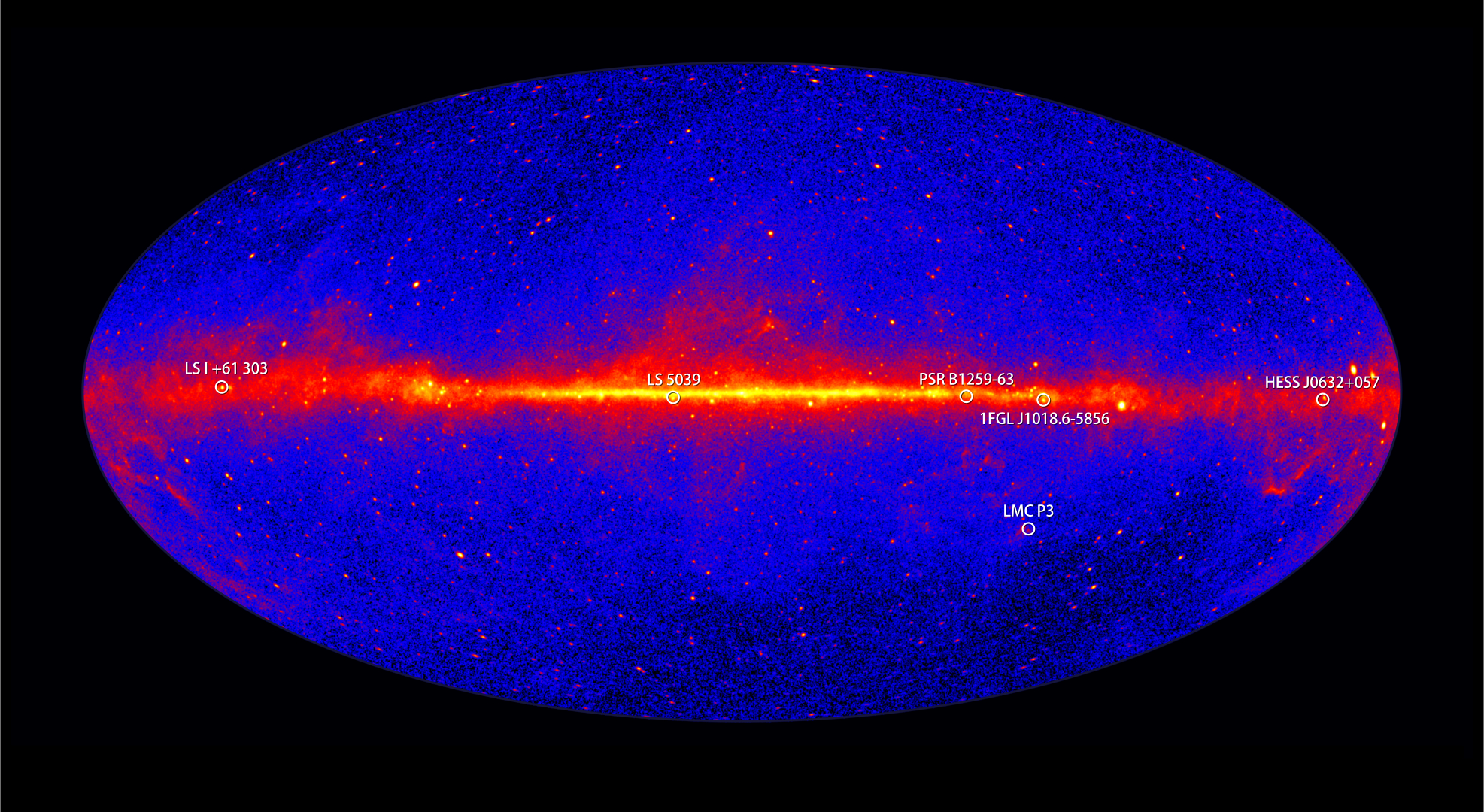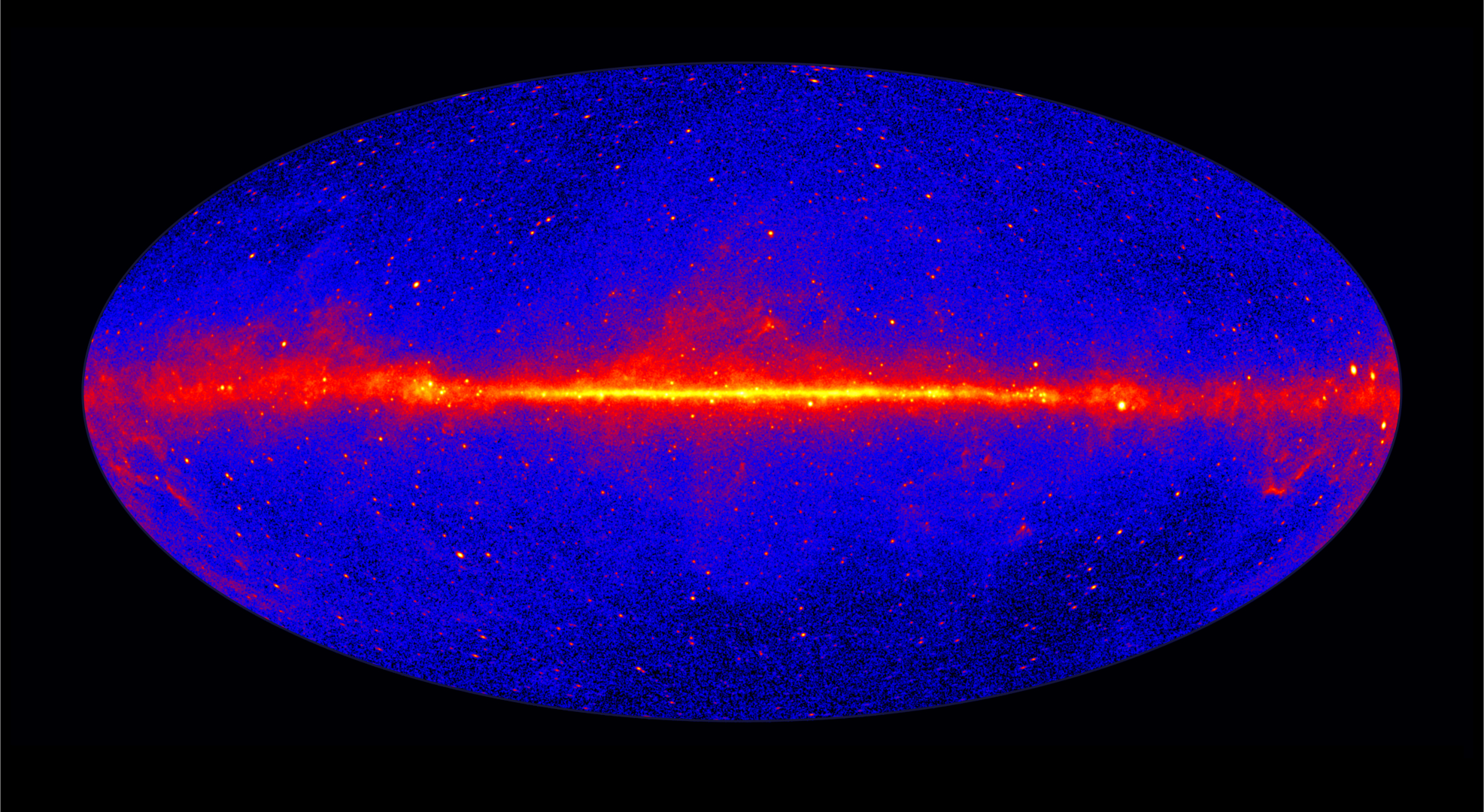Universe
ID: 12376
Using data from NASA's Fermi Gamma-ray Space Telescope and other facilities, scientists have found the first gamma-ray binary in another galaxy and the most luminous one ever seen. The dual-star system, dubbed LMC P3, contains a massive star and a crushed stellar core that interact to produce a cyclic flood of gamma rays, the highest-energy form of light.
Gamma-ray binaries are rare -- only six are known in our own galaxy, and one remains undetected by Fermi. The systems are prized because their gamma-ray output changes significantly during each orbit and sometimes over longer time scales. This variation lets astronomers study many of the emission processes common to other gamma-ray sources in unique detail.
The systems contain either a neutron star or a black hole and radiate most of their energy in the form of gamma rays. Remarkably, LMC P3 is the most luminous such system known in gamma rays, X-rays, radio waves and visible light, and it's only the second one discovered with Fermi.
LMC P3 lies within a supernova remnant located in the Large Magellanic Cloud (LMC), a small nearby galaxy about 163,000 light-years away. In 2012, scientists using NASA's Chandra X-ray Observatory found a strong X-ray source within the remnant and showed that it was orbiting a hot, young star many times the sun's mass. The researchers concluded the compact object was either a neutron star or a black hole and classified the system as a high-mass X-ray binary (HMXB).
In 2015, a team led by Robin Corbet at NASA's Goddard Space Flight Center began looking for new gamma-ray binaries in Fermi data by searching for the periodic changes characteristic of these systems. The scientists discovered a 10.3-day cyclic change centered near one of several gamma-ray point sources recently identified in the LMC. One of them, called P3, was not linked to objects seen at any other wavelengths but was located near the HMXB. Were they the same object?
Observations from NASA's Swift satellite clearly reveal the same 10.3-day cycle seen in gamma rays by Fermi. They also indicate that the brightest X-ray emission occurs opposite the gamma-ray peak, so when one reaches maximum the other is at minimum. Radio data exhibit the same period and out-of-phase relationship with the gamma-ray peak, confirming that LMC P3 is indeed the same system investigated by Chandra.
Prior to Fermi's launch, gamma-ray binaries were expected to be more numerous than they've turned out to be. It's a puzzle because hundreds of HMXBs are cataloged, and all of them are thought to have originated as gamma-ray binaries following the supernova that formed the compact object. Its possible gamma-ray binaries may form only from neutron stars born with the fastest spins, which would enhance their ability to produce gamma rays.





Fermi Finds Record-breaking Gamma-ray Binary
Gamma-ray binaries are rare -- only six are known in our own galaxy, and one remains undetected by Fermi. The systems are prized because their gamma-ray output changes significantly during each orbit and sometimes over longer time scales. This variation lets astronomers study many of the emission processes common to other gamma-ray sources in unique detail.
The systems contain either a neutron star or a black hole and radiate most of their energy in the form of gamma rays. Remarkably, LMC P3 is the most luminous such system known in gamma rays, X-rays, radio waves and visible light, and it's only the second one discovered with Fermi.
LMC P3 lies within a supernova remnant located in the Large Magellanic Cloud (LMC), a small nearby galaxy about 163,000 light-years away. In 2012, scientists using NASA's Chandra X-ray Observatory found a strong X-ray source within the remnant and showed that it was orbiting a hot, young star many times the sun's mass. The researchers concluded the compact object was either a neutron star or a black hole and classified the system as a high-mass X-ray binary (HMXB).
In 2015, a team led by Robin Corbet at NASA's Goddard Space Flight Center began looking for new gamma-ray binaries in Fermi data by searching for the periodic changes characteristic of these systems. The scientists discovered a 10.3-day cyclic change centered near one of several gamma-ray point sources recently identified in the LMC. One of them, called P3, was not linked to objects seen at any other wavelengths but was located near the HMXB. Were they the same object?
Observations from NASA's Swift satellite clearly reveal the same 10.3-day cycle seen in gamma rays by Fermi. They also indicate that the brightest X-ray emission occurs opposite the gamma-ray peak, so when one reaches maximum the other is at minimum. Radio data exhibit the same period and out-of-phase relationship with the gamma-ray peak, confirming that LMC P3 is indeed the same system investigated by Chandra.
Prior to Fermi's launch, gamma-ray binaries were expected to be more numerous than they've turned out to be. It's a puzzle because hundreds of HMXBs are cataloged, and all of them are thought to have originated as gamma-ray binaries following the supernova that formed the compact object. Its possible gamma-ray binaries may form only from neutron stars born with the fastest spins, which would enhance their ability to produce gamma rays.





Used Elsewhere In
For More Information
Credits
Scott Wiessinger (USRA): Lead Producer
Scott Wiessinger (USRA): Lead Animator
Francis Reddy (Syneren Technologies): Lead Science Writer
Francis Reddy (Syneren Technologies): Graphics
Scott Wiessinger (USRA): Lead Animator
Francis Reddy (Syneren Technologies): Lead Science Writer
Francis Reddy (Syneren Technologies): Graphics
Please give credit for this item to:
NASA's Goddard Space Flight Center. However, individual items should be credited as indicated above.
NASA's Goddard Space Flight Center. However, individual items should be credited as indicated above.
Short URL to share this page:
https://svs.gsfc.nasa.gov/12376
Mission:
Fermi Gamma-ray Space Telescope
This item is part of these series:
Narrated Movies
Astrophysics Animations
Astrophysics Stills
Astrophysics Features
Keywords:
SVS >> Galaxy
SVS >> HDTV
SVS >> Neutron Star
SVS >> X-ray
GCMD >> Earth Science >> Spectral/Engineering >> Gamma Ray
SVS >> Gamma Ray Burst
SVS >> Astrophysics
SVS >> Space
SVS >> Fermi
SVS >> Supernova
SVS >> Star
NASA Science >> Universe
GCMD keywords can be found on the Internet with the following citation: Olsen, L.M., G. Major, K. Shein, J. Scialdone, S. Ritz, T. Stevens, M. Morahan, A. Aleman, R. Vogel, S. Leicester, H. Weir, M. Meaux, S. Grebas, C.Solomon, M. Holland, T. Northcutt, R. A. Restrepo, R. Bilodeau, 2013. NASA/Global Change Master Directory (GCMD) Earth Science Keywords. Version 8.0.0.0.0
https://svs.gsfc.nasa.gov/12376
Mission:
Fermi Gamma-ray Space Telescope
This item is part of these series:
Narrated Movies
Astrophysics Animations
Astrophysics Stills
Astrophysics Features
Keywords:
SVS >> Galaxy
SVS >> HDTV
SVS >> Neutron Star
SVS >> X-ray
GCMD >> Earth Science >> Spectral/Engineering >> Gamma Ray
SVS >> Gamma Ray Burst
SVS >> Astrophysics
SVS >> Space
SVS >> Fermi
SVS >> Supernova
SVS >> Star
NASA Science >> Universe
GCMD keywords can be found on the Internet with the following citation: Olsen, L.M., G. Major, K. Shein, J. Scialdone, S. Ritz, T. Stevens, M. Morahan, A. Aleman, R. Vogel, S. Leicester, H. Weir, M. Meaux, S. Grebas, C.Solomon, M. Holland, T. Northcutt, R. A. Restrepo, R. Bilodeau, 2013. NASA/Global Change Master Directory (GCMD) Earth Science Keywords. Version 8.0.0.0.0












